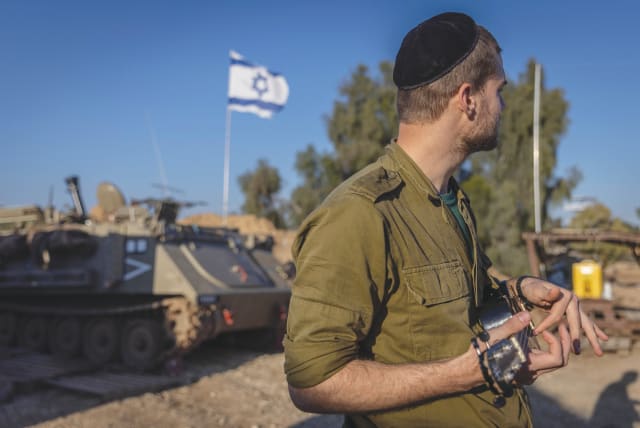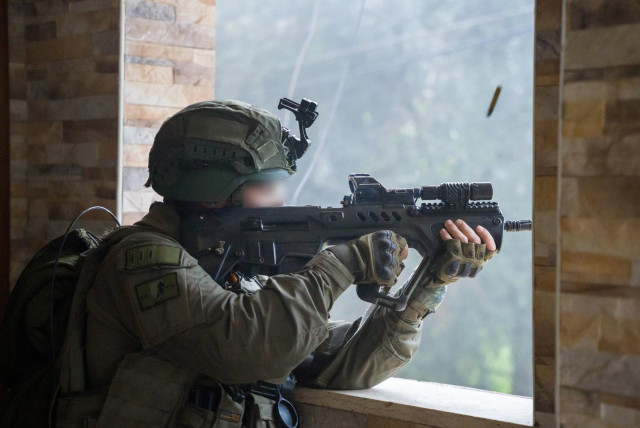Colors of pride: Blue-and-white Israel rallies behind IDF green - opinion

The Israeli army has become the most powerful national symbol of pride. The color green wasn’t central to the Mikdash, but it has become a compelling modern symbol.
Clothing is an important form of self-expression. The clothes we wear reflect our personal tastes, preferences, and identities. Likewise, clothing often manifests our cultural and communal values. For Jews, clothing has always served as a cultural identifier. Our sages stress that despite our religious collapse in Egypt and while living under duress, we maintained a distinctly Jewish form of dress, enabling us to preserve a robust Jewish identity.
Many sects of Orthodox Jews still employ clothing as a cultural insulator to preserve traditionalism. Hassidim in particular punctiliously preserve clothing styles of the past to more strongly anchor themselves to tradition and to fend off the seductive impulses of modernity.
Though we express ourselves through clothing, we also view dress as a means of protecting personal modesty. Tzniyut (modesty) is not a dress code for women but an overarching attitude or a general pattern of behavior that applies to both men and women. Tzniyut urges us not to call too much attention to ourselves and not to aggressively promote personal accomplishments. Dressing modestly is just one expression of proper manners and understated deportment.
In stark contrast to general Jewish dress codes, the uniform of the Kohen gadol, the high priest in the Holy Temple, was eye-catchingly stunning. He wore dazzling jewels in the choshen (breastplate) and carried large gemstones, or avnei shoham, on his shoulder pads. He placed a shimmering gold sheet across his forehead (known as the tzitz), fastening it to his head with glistening strings dyed in the royal blue color of tehelet. On top of his general clothing, he sported a lavish topcoat called the me’il, which was trimmed with pomegranate-shaped ornaments and miniature Baroque-style bells.
For a culture that discourages ostentation and flashiness, the attire of the Kohen gadol seems aberrant. His glittering clothing clashes with our overall inclination to dress quietly and discreetly.
The institution
The flashy clothing of the Kohen gadol wasn’t “personal.” The Torah itself recognizes that this splendor was meant to arouse deeper reverence for God while evoking kavod and tiferet, honor and glory, for the Mikdash, the Temple. As the central figure of the Mikdash, the Kohen gadol symbolized an institution much larger than himself. His regal clothing imbued the Mikdash with a majestic ambience and ceremonial gravitas. As he represented a national institution, the Kohen gadol’s clothing didn’t violate codes of modesty. His royal garb didn’t call attention to himself but connected us with something larger. He was a connector, not a self-promoter.
Broken Kohanim
Twice during Jewish history, Kohanim misused their office, deeply damaging the larger institution of the Mikdash that they were meant to honor. During the era of The Judges, two children of Eli, the serving Kohen gadol, mistreated women who visited the Mikdash to deliver their postpartum sacrifices. This corruption of power wasn’t just flagrant moral hypocrisy by public officials. Their scandalous behavior weakened public trust in institutions in general. Suspicion is contagious, and once it gains footing it spreads to other elements of society. Their abuse of power destabilized general institutions of authority, forcing God to reboot society by launching the Jewish monarchy.
Hundreds of years later, during the Second Temple era, the Sadducees gained control of the office of the Kohen gadol and regularly sabotaged the solemn Yom Kippur ceremonies in the inner sanctum. They didn’t just erode public trust in Kohanim, but they destroyed social attitudes toward the “establishment.” Sadly, the Second Temple era was derailed by vicious social strife and violent civil wars. Trust in the public institutions that could have unified us had completely eroded. Without these unifying national institutions, we fell into social chaos and disunity.
By dressing in regal attire, the Kohen gadol preserves the dignity of the Mikdash as an institution and as a unifying symbol. Despite natural differences of background, religion, and orientation, the entire country rallied around the Mikdash, pilgrimaging to Jerusalem three times a year. The dazzling colors and glistening gold of the Kohen gadol’s clothing were national symbols of glory.
A new color
Over the past few months, we have been unified by a different uniform and a very different color. Sadly, we haven’t yet rebuilt the Mikdash, and our eyes have yet to behold its vibrant colors and the uniform of the Kohen. For us, though, the color green has become a unifying symbol of Jewish hopes and dreams. After we were viciously attacked on October 7, our Jewish army valiantly battled to restore our borders and to purge Gaza of homicidal murderers. Their green uniforms haven’t left our hearts or our imaginations. We have prayed for our soldiers’ welfare while also burying heroes who sacrificed their lives for our people, our country, and our future. We pictured soldiers living in their uniforms for weeks at a time, facing deranged murderers and braving harsh weather conditions. We stood at weddings and sat in shiva (mourning) homes next to soldiers in their green uniforms, released for just a few hours, who didn’t have ample time or opportunity to change into civilian clothing.
Their IDF fatigues are not as resplendent as the uniform of the Kohen gadol. Their sandy shoes aren’t as polished as the metallic sheen of the Kohen’s head plate. Their chests are safeguarded with ceramic plates rather than bedecked with precious stones. Their heads are covered with protective helmets rather than stately caps. They string weapons, not gemstones, over their shoulders. The color of the uniform may be drab, but it resonates with our collective hopes for recovery, security, and sovereignty. They have become modern-day versions of kavod and tiferet. Standing next to Jewish soldiers has infused us with pride, strength, patriotism, and mesirat nefesh (self-sacrifice). It is our honor to witness our children, our brothers and sisters, and our husbands and fathers wearing this uniform of Jewish pride.
Evil soldiers
It wasn’t always this way. For centuries, the image of a soldier had sinister connotations. Soldiers could easily torture, murder, and rape Jews with impunity. Many illuminated Haggadot (Passover Seder guides) portray the Four Sons with suggestive avatars. Invariably, the wicked son was depicted as a soldier – a Roman soldier, a Greek soldier, a Spanish soldier, a Persian soldier, or a Russian soldier. For centuries, soldiers represented horror and dread, and their uniforms and military symbols were both repugnant and terrifying.
Jewish history is undergoing a revolution, as Jewish soldiers have become national symbols of hope, strength, and, in the past few months, Jewish resilience. What made Oct. 7 so traumatic was, in part, the belief that our Jewish army could completely defend us in our homeland. We thought that a Jewish army would protect us against the savage crimes perpetrated against us in the past. Pogroms against defenseless Jews, we believed, were a relic of a time when we didn’t have a Jewish army to defend us. We were wrong, and in the aftermath of this war we will thoroughly investigate how this tragedy occurred and why our army failed to protect us.
Despite this letdown, and perhaps because of it, our identification with the IDF hasn’t waned; if anything, the Israeli army has become the most powerful national symbol of pride. The army has become the institution that unites Jews across the world and across the ideological spectrum. The color green wasn’t central to the Mikdash, but it has become a compelling modern symbol. As we return to Israel, the palette of Jewish history changes.
The writer is a rabbi at Yeshivat Har Etzion/Gush, a hesder yeshiva. He has smicha (rabbinic ordination) and a BA in computer science from Yeshiva University, as well as a master’s degree in English literature from the City University of New York.
Jerusalem Post Store
`; document.getElementById("linkPremium").innerHTML = cont; var divWithLink = document.getElementById("premium-link"); if (divWithLink !== null && divWithLink !== 'undefined') { divWithLink.style.border = "solid 1px #cb0f3e"; divWithLink.style.textAlign = "center"; divWithLink.style.marginBottom = "15px"; divWithLink.style.marginTop = "15px"; divWithLink.style.width = "100%"; divWithLink.style.backgroundColor = "#122952"; divWithLink.style.color = "#ffffff"; divWithLink.style.lineHeight = "1.5"; } } (function (v, i) { });

